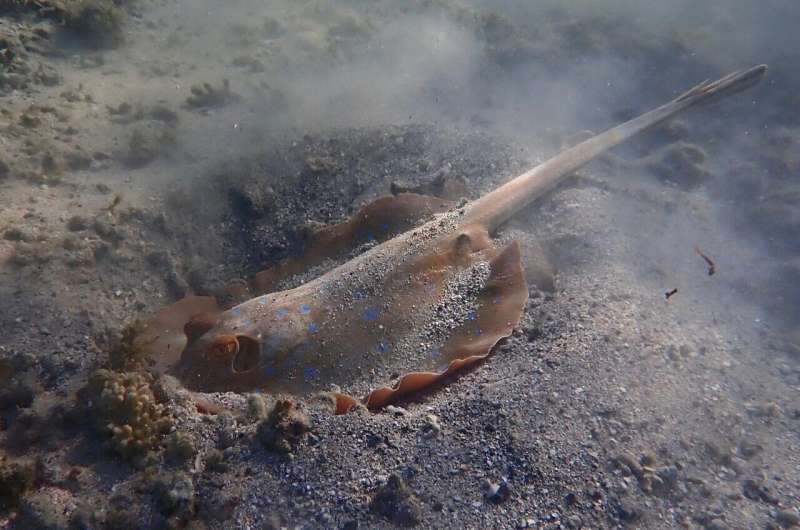Location of the five beaches surveyed in Drawaqa Island, in Western Fiji. Credit: Frontiers in Marine Science (2024). DOI: 10.3389/fmars.2024.1401258
The team focused their observation area near and on five beaches in the northern area of western Fiji’s uninhabited Drawaqa Island. From January–March 2024, they documented T. lessoni appearances during 105 total observational surveys on 40 different days.
According to the research paper, “Each survey lasted 45 min for standardization, and were [sic] conducted as roving explorations, including 53 snorkel surveys, 32 beach walks, and 20 SCUBA dives.” The team also noted the corresponding ocean temperature for each survey.
As frequently as they could, the researchers photographed T. lessoni specimens and recorded their individual features, noting aspects such as individual markings; size (measured by disk width [DW], the maximum distance between wingtips); convex dorsum (a sign of advanced gestation); concave dorsum (a sign of recent parturition); and fresh bite wounds (indicating procreational behavior). The presence of claspers indicated male rays, while females had none.
With limited literature on this species to guide them, the team drew occasional comparisons between their observations of T. lessoni and earlier findings on the bluespotted ribbontail ray, T. lymma, a more widely distributed nearshore species found throughout the tropical Indian and western Pacific Oceans.
Photographs of individual T. lessoni in advanced gestation observed at Sunrise Beach, Drawaqa Island, with convex dorsa, indicative for advanced gestation. Encircled in red are selected differentiating features: Individual 1 displays single antorbital blue spots, and a row of three prominent vertical blue spots followed by a row of horizontal blue spots posterolateral; Individual 2 has two antorbital blue spots; Individual 3 features a plain antorbital area, including a tail partly cut, and Individual 4 has scapular and posterolateral rows of three blue spots. Credit: Frontiers in Marine Science (2024). DOI: 10.3389/fmars.2024.1401258
Notable findings
During the study period, water temperatures ranged from 28.22° C to 33.08° C. The team observed T. lessoni specimens during 71 of their 105 surveys (67.6%). Most of these rays appeared during snorkeling (48), with another 15 appearing during beach walks and eight more—all mature adults—during dives.
“Mature females and males were mostly observed during snorkeling surveys, while immature specimens were predominantly sighted during beach walks,” the researchers note.
Beginning in early January, the team observed four females (≤ 8m in depth) in advanced gestation in shallow waters at a single site. Altogether, these four females (referred to in the paper as Individuals 1–4) appeared 24 times throughout the study.
The team noted indications of parturition for three of these four between the end of February and mid-March, and the paper documents observations of ten individual neonates, which all appeared during snorkeling and beach walks.
Visual comparison of Individuals 1, 2, and 3 during advanced gestation (A, C, E) and post-partum (B, D, F) stages. Image (A) of Individual 1 was taken on February 3, 2024, during advanced gestation, while (B) was captured on February 29, 2024, post-partum. Image (C) shows Individual 2 on January 13, 2024, during advanced gestation, and (D) on March 12, 2024, post-partum. Image (E) shows Individual 3 on February 11, 2024, during pregnancy, and (F) on March 4, 2024, post-partum. Credit: Frontiers in Marine Science (2024). DOI: 10.3389/fmars.2024.1401258
“The presence of neonates from early March onward coincided with the estimated parturition period inferred from the rays’ condition,”‘ the researchers write. “We were unable to determine the periodicity of the reproductive cycle and the gestation period, but T. lessoni may reproduce asynchronously and aseasonally.”
Moreover, the team noticed a dermal wound near Individual 1’s left pectoral fin at some point after parturition, suggesting “a bite or abrasion from a pectoral grip or pre-copulatory biting, indicating that copulation may occur soon or immediately after parturition, as observed in captive T. lymma (Smith et al., 2017). Therefore, a continuous cycle with the potential for multiple pregnancies annually seems likely,” the paper states.
As a next step, the researchers suggest an acoustic telemetry study and continued collection of environmental data to shed more light on T. lessoni’s presence, behavior, and site fidelity.
“Our preliminary data indicate that Drawaqa’s nearshore waters likely serve as pupping grounds for T. lessoni,” they conclude. “Considering this, along with the diversity of species, the easy accessibility, and the continued monitoring setup, this location is ideal for further studies to deepen our understanding of ray ecology and biology.”
More information:
Kerstin Glaus et al, Observational data on the reproductive condition of female Oceania fantail rays, Taeniura lessoni, from Drawaqa Island, Fiji, Frontiers in Marine Science (2024). DOI: 10.3389/fmars.2024.1401258
© 2024 Science X Network
Citation:
New study augments distribution and reproduction data for little-known female Oceania fantail rays (2024, July 8)
retrieved 9 July 2024
from https://phys.org/news/2024-07-augments-reproduction-female-oceania-fantail.html
This document is subject to copyright. Apart from any fair dealing for the purpose of private study or research, no
part may be reproduced without the written permission. The content is provided for information purposes only.
Source link : https://phys.org/news/2024-07-augments-reproduction-female-oceania-fantail.html
Author :
Publish date : 2024-07-08 09:50:01
Copyright for syndicated content belongs to the linked Source.
